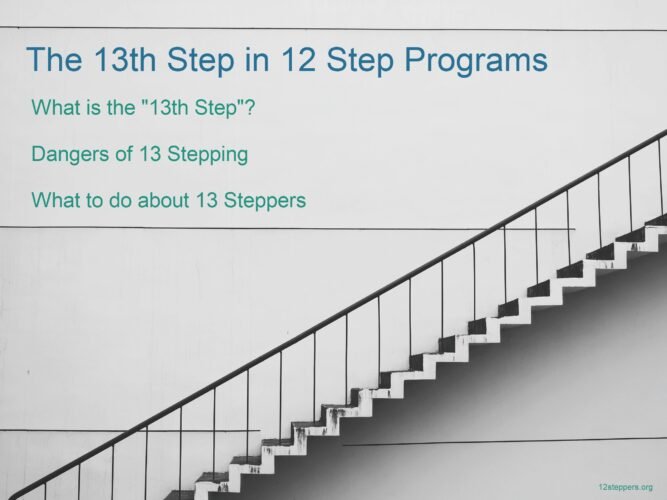The 12-step concept is the cornerstone of the various groups which emerged from Alcoholics Anonymous, including Sexaholics Anonymous. Though tailored to alleviate the affliction of sexual addiction, it follows the basic contours outlined in the “Big Book of AA” over eighty years ago. The stepsThe term "12 steps" refers to the core principles of the approach to addiction exemplified by Alcoholics Anonymous and other similar groups. The 12 steps are a set of guidelines designed to help individuals overcome addiction and rebuild their lives. They were created by the founders of Alcoholics A... More are:
Step 1: We admitted that we were powerless over lust—that our lives had become unmanageable.
In this step, we admit that the path we have followed thus far has led us to life of desperation based on a ceaseless pursuit of lust. In order to rectify this, we admit addiction and fruitless attempts at self-reliance have made our life intolerable.
Step 2: Came to believe that a Power greater than ourselves could restore us to sanity.
In the second step, we identify a spiritual force which has the power to overcome the unmanageability of our loves. The programThis refers to any official course of treatment for addiction. This could be anything from in-patient facilities, to 12-step programs to harm-reduction programs. More does not proscribe which power it is, it can be anywhere from traditional religion to the SA group itself. The important part is we believe this Power has a beneficial plan for us.
Step 3: Made a decision to turn our will and our lives over to the care of God as we understood Him.
Believing a Higher Power can make our lives better, in the third we decide to cease clinging to destructive lustful patterns. In order to do so, we must cultivate faith that our spiritual guide has a better path in store for us.
Step 4: Made a searching and fearless moral inventory of ourselves.
Now guided by a Higher Power12-step programs greatly stress surrender to and daily communication with a Higher Power. Having trust in something greater than yourself is considered essential for returning sanity in the unmanageable life of an addict. This can be a traditional deity, a spiritual entity or a social one such as th... More, we are ready to face ourselves frankly. This requires examining our failings, but also the positive attributes which can help us recover. In this process we avoid the twin pitfalls of self-shaming and self-aggrandizing.
Step 5: Admitted to God, to ourselves, and to another human being the exact nature of our wrongs.
With a better understanding of our failings, we are ready to shed the isolation and shameFeelings of shame and inadequacy often contribute both to the onset of addiction and its continuation. Addicts also often commit immoral acts, leading to further shame. This leads to a destructive shame-addiction cycle. Breaking the cycle is one of the keys to recovery. More which accompany our lust. By talking openly of our failings to others and our Higher Power, we cultivate our humility and willingness to follow a new and better path.
Step 6: Were entirely ready to have God remove all these defects of character.
Having identified our failings, we realize that we have been clinging to them. In the sixth-step we release our attachment to our flaws in the hope that our Higher Power will remove them. This does not mean we demand their removal. Rather we relinquish our attempts at control over our frailties.
Step 7: Humbly asked Him to remove our shortcomings.
The first six-steps have allowed us to embrace humility. This has rendered us ready to ask our Higher Power to forgive our sins and take our frailties away. We do not bargain with God or make demands as we had in the past. Rather, we humbly ask that a better path in keeping with the plan of our higher power be revealed.
Step 8: Made a list of all persons we had harmed, and became willing to make amends to them all.
Having allowed ourselves to follow a better path, we are now ready to improve our relations with every person we know. This applies in particular to those we have harmed by acting out on our lust. In order to further this goal, we make an honest and expansive list of those our actions injured in any way. This means focusing on our own misdeeds, and letting go of anger towards the perceived misdeeds of others.
Step 9: Made direct amends to such people wherever possible, except when to do so would injure them or others.
We then attempt to make honestly amends to those individuals on the list we compiled in the previous step. Direct amends are made whenever possible, as long as the contact will not cause actual harm to the person to whom we are making amends. The purpose of the step is to take responsibility for our own actions as well as for the well-being of others.
Step 10: Continued to take personal inventory and when we were wrong, promptly admitted it.
In this step we do not rest on the laurels of the change we have pursued and attained as we progress in the steps. By taking an inventoryStep 4 recommends the addict conduct “a searching and fearless moral inventory.” This involves coming to terms with the flaws which preceded addiction and those that came as a result of it. More of what we are doing wrong currently and admitting it, we make sure to solidify the favorable path we now follow. This also reminds us of our flaws and maintains our humility, even as our lives begin to improve.
Step 11: Sought through prayer and meditation to improve our conscious contact with God as we understood Him, praying only for knowledge of His will for us and the power to carry that out.
In order to remain on the path to recoveryThe process by which addicts attempt to break the hold a certain substance or behavior has on their lives. This can refer to participation in a wide variety of methods. What they all have in common, is a sense that life is improving and the addict is regaining control. More, we engage our Higher Power through prayer and listen through meditation. We do not petition for our desired outcomes. After all, our judgement has proven unsound and led us to lust. Instead we ask for guidance to follow the will of our Higher Power.
Step 12: Having had a spiritual awakening as the result of these Steps, we tried to carry this message to sexaholics, and to practice these principles in all our affairs.
At this point we are on a better path and are no longer ruled by lust. We now allow the principles we have learned on this journey to guide us in all aspects of our existence, even when lust is not relevant to the issue at hand. Firmly on the path our Higher Power has designated for us, we attempt to bring hope to those still afflicted by addiction.
The 12-steps of SA are not for everyone. However, they represent a tried and true blueprint for recovery from the ravages of lust, which have benefited many and allowed them to regain control of their lives from the powerlessness of an existence controlled by lust.







